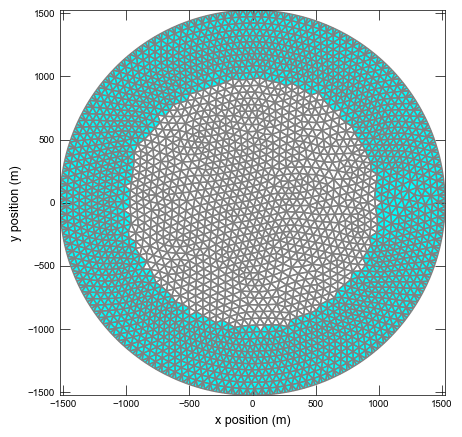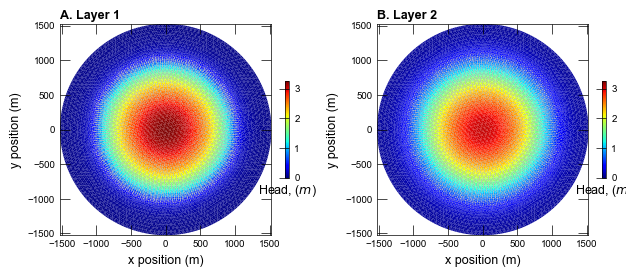This page was generated from
ex-gwf-disvmesh.py.
It's also available as a notebook.
USG1DISV example
Demonstration of a triangular mesh with the DISV Package to discretize a circular island with a radius of 1500 meters. The model has 2 layers and uses 2778 vertices (NVERT) to delineate 5240 cells per layer (NCPL). General-head boundaries are assigned to model layer 1 for cells outside of a 1025 m radius circle. Recharge is applied to the top of the model.
Initial setup
Import dependencies, define the example name and workspace, and read settings from environment variables.
[1]:
import os
import pathlib as pl
import flopy
import flopy.utils.cvfdutil
import git
import matplotlib.pyplot as plt
import numpy as np
import pooch
from flopy.plot.styles import styles
from flopy.utils.geometry import get_polygon_area
from flopy.utils.gridintersect import GridIntersect
from modflow_devtools.misc import get_env, timed
from shapely.geometry import Polygon
# Example name and workspace paths. If this example is running
# in the git repository, use the folder structure described in
# the README. Otherwise just use the current working directory.
sim_name = "ex-gwf-disvmesh"
try:
root = pl.Path(git.Repo(".", search_parent_directories=True).working_dir)
except:
root = None
workspace = root / "examples" if root else pl.Path.cwd()
figs_path = root / "figures" if root else pl.Path.cwd()
data_path = root / "data" / sim_name if root else pl.Path.cwd()
# Settings from environment variables
write = get_env("WRITE", True)
run = get_env("RUN", True)
plot = get_env("PLOT", True)
plot_show = get_env("PLOT_SHOW", True)
plot_save = get_env("PLOT_SAVE", True)
Define parameters
Define model units, parameters and other settings.
[2]:
# Model units
length_units = "meters"
time_units = "days"
# Model parameters
nper = 1 # Number of periods
nlay = 2 # Number of layers
top = 0.0 # Top of the model ($m$)
botm_str = "-20.0, -40.0" # Layer bottom elevations ($m$)
strt = 0.0 # Starting head ($m$)
icelltype = 0 # Cell conversion type
k11 = 10.0 # Horizontal hydraulic conductivity ($m/d$)
k33 = 0.2 # Vertical hydraulic conductivity ($m/d$)
recharge = 4.0e-3 # Recharge rate ($m/d$)
# Static temporal data used by TDIS file
# Simulation has 1 steady stress period (1 day).
perlen = [1.0]
nstp = [1]
tsmult = [1.0]
tdis_ds = list(zip(perlen, nstp, tsmult))
# Parse strings into lists
botm = [float(value) for value in botm_str.split(",")]
# create the disv grid
def from_argus_export(fname):
f = open(fname)
line = f.readline()
ll = line.split()
ncells, nverts = ll[0:2]
ncells = int(ncells)
nverts = int(nverts)
verts = np.empty((nverts, 2), dtype=float)
# read the vertices
f.readline()
for ivert in range(nverts):
line = f.readline()
ll = line.split()
c, iv, x, y = ll[0:4]
verts[ivert, 0] = x
verts[ivert, 1] = y
# read the cell information and create iverts
iverts = []
for icell in range(ncells):
line = f.readline()
ll = line.split()
ivlist = []
for ic in ll[2:5]:
ivlist.append(int(ic) - 1)
if ivlist[0] != ivlist[-1]:
ivlist.append(ivlist[0])
ivlist.reverse()
iverts.append(ivlist)
# close file and return spatial reference
f.close()
return verts, iverts
# Load argus mesh and get disv grid properties
fname = "argus.exp"
fpath = pooch.retrieve(
url=f"https://github.com/MODFLOW-USGS/modflow6-examples/raw/master/data/{sim_name}/{fname}",
fname=fname,
path=data_path,
known_hash="md5:072a758ca3d35831acb7e1e27e7b8524",
)
verts, iverts = from_argus_export(fpath)
gridprops = flopy.utils.cvfdutil.get_disv_gridprops(verts, iverts)
cell_areas = []
for i in range(gridprops["ncpl"]):
x = verts[iverts[i], 0]
y = verts[iverts[i], 1]
cell_verts = np.vstack((x, y)).transpose()
cell_areas.append(get_polygon_area(cell_verts))
# Solver parameters
nouter = 50
ninner = 100
hclose = 1e-9
rclose = 1e-6
Model setup
Define functions to build models, write input files, and run the simulation.
[3]:
def build_models(sim_name):
sim_ws = os.path.join(workspace, sim_name)
sim = flopy.mf6.MFSimulation(sim_name=sim_name, sim_ws=sim_ws, exe_name="mf6")
flopy.mf6.ModflowTdis(sim, nper=nper, perioddata=tdis_ds, time_units=time_units)
flopy.mf6.ModflowIms(
sim,
linear_acceleration="bicgstab",
outer_maximum=nouter,
outer_dvclose=hclose,
inner_maximum=ninner,
inner_dvclose=hclose,
rcloserecord=f"{rclose} strict",
)
gwf = flopy.mf6.ModflowGwf(sim, modelname=sim_name, save_flows=True)
flopy.mf6.ModflowGwfdisv(
gwf,
length_units=length_units,
nlay=nlay,
top=top,
botm=botm,
**gridprops,
)
flopy.mf6.ModflowGwfnpf(
gwf,
icelltype=icelltype,
k=k11,
k33=k33,
save_specific_discharge=True,
xt3doptions=True,
)
flopy.mf6.ModflowGwfic(gwf, strt=strt)
theta = np.arange(0.0, 2 * np.pi, 0.2)
radius = 1500.0
x = radius * np.cos(theta)
y = radius * np.sin(theta)
outer = [(x, y) for x, y in zip(x, y)]
radius = 1025.0
x = radius * np.cos(theta)
y = radius * np.sin(theta)
hole = [(x, y) for x, y in zip(x, y)]
p = Polygon(outer, holes=[hole])
ix = GridIntersect(gwf.modelgrid, method="vertex", rtree=True)
result = ix.intersect(p)
ghb_cellids = np.array(result["cellids"], dtype=int)
ghb_spd = []
ghb_spd += [[0, i, 0.0, k33 * cell_areas[i] / 10.0] for i in ghb_cellids]
ghb_spd = {0: ghb_spd}
flopy.mf6.ModflowGwfghb(
gwf,
stress_period_data=ghb_spd,
pname="GHB",
)
ncpl = gridprops["ncpl"]
rchcells = np.array(list(range(ncpl)), dtype=int)
rchcells[ghb_cellids] = -1
rch_spd = [(0, rchcells[i], recharge) for i in range(ncpl) if rchcells[i] > 0]
rch_spd = {0: rch_spd}
flopy.mf6.ModflowGwfrch(gwf, stress_period_data=rch_spd, pname="RCH")
head_filerecord = f"{sim_name}.hds"
budget_filerecord = f"{sim_name}.cbc"
flopy.mf6.ModflowGwfoc(
gwf,
head_filerecord=head_filerecord,
budget_filerecord=budget_filerecord,
saverecord=[("HEAD", "ALL"), ("BUDGET", "ALL")],
)
return sim
def write_models(sim, silent=True):
sim.write_simulation(silent=silent)
@timed
def run_models(sim, silent=False):
success, buff = sim.run_simulation(silent=silent, report=True)
assert success, buff
Plotting results
Define functions to plot model results.
[4]:
# Figure properties
figure_size = (5, 5)
def plot_grid(idx, sim):
with styles.USGSMap():
sim_ws = os.path.join(workspace, sim_name)
gwf = sim.get_model(sim_name)
fig = plt.figure(figsize=figure_size)
fig.tight_layout()
ax = fig.add_subplot(1, 1, 1, aspect="equal")
pmv = flopy.plot.PlotMapView(model=gwf, ax=ax, layer=0)
pmv.plot_grid(linewidth=1)
pmv.plot_bc(name="GHB")
ax.set_xlabel("x position (m)")
ax.set_ylabel("y position (m)")
if plot_show:
plt.show()
if plot_save:
fpth = figs_path / f"{sim_name}-grid.png"
fig.savefig(fpth)
def plot_head(idx, sim):
with styles.USGSMap():
sim_ws = os.path.join(workspace, sim_name)
gwf = sim.get_model(sim_name)
fig = plt.figure(figsize=(7.5, 5))
fig.tight_layout()
head = gwf.output.head().get_data()[:, 0, :]
# create MODFLOW 6 cell-by-cell budget object
qx, qy, qz = flopy.utils.postprocessing.get_specific_discharge(
gwf.output.budget().get_data(text="DATA-SPDIS", totim=1.0)[0],
gwf,
)
ax = fig.add_subplot(1, 2, 1, aspect="equal")
pmv = flopy.plot.PlotMapView(model=gwf, ax=ax, layer=0)
cb = pmv.plot_array(head, cmap="jet", vmin=0.0, vmax=head.max())
pmv.plot_vector(
qx,
qy,
normalize=False,
color="0.75",
)
cbar = plt.colorbar(cb, shrink=0.25)
cbar.ax.set_xlabel(r"Head, ($m$)")
ax.set_xlabel("x position (m)")
ax.set_ylabel("y position (m)")
styles.heading(ax, letter="A", heading="Layer 1")
ax = fig.add_subplot(1, 2, 2, aspect="equal")
pmv = flopy.plot.PlotMapView(model=gwf, ax=ax, layer=1)
cb = pmv.plot_array(head, cmap="jet", vmin=0.0, vmax=head.max())
pmv.plot_vector(
qx,
qy,
normalize=False,
color="0.75",
)
cbar = plt.colorbar(cb, shrink=0.25)
cbar.ax.set_xlabel(r"Head, ($m$)")
ax.set_xlabel("x position (m)")
ax.set_ylabel("y position (m)")
styles.heading(ax, letter="B", heading="Layer 2")
if plot_show:
plt.show()
if plot_save:
fpth = figs_path / f"{sim_name}-head.png"
fig.savefig(fpth)
def plot_results(idx, sim, silent=True):
if idx == 0:
plot_grid(idx, sim)
plot_head(idx, sim)
Running the example
Define and invoke a function to run the example scenario, then plot results.
[5]:
def scenario(idx, silent=True):
sim = build_models(sim_name)
if write:
write_models(sim, silent=silent)
if run:
run_models(sim, silent=silent)
if plot:
plot_results(idx, sim, silent=silent)
scenario(0)
<flopy.mf6.data.mfstructure.MFDataItemStructure object at 0x7f33e5ddba90>
run_models took 222.09 ms

